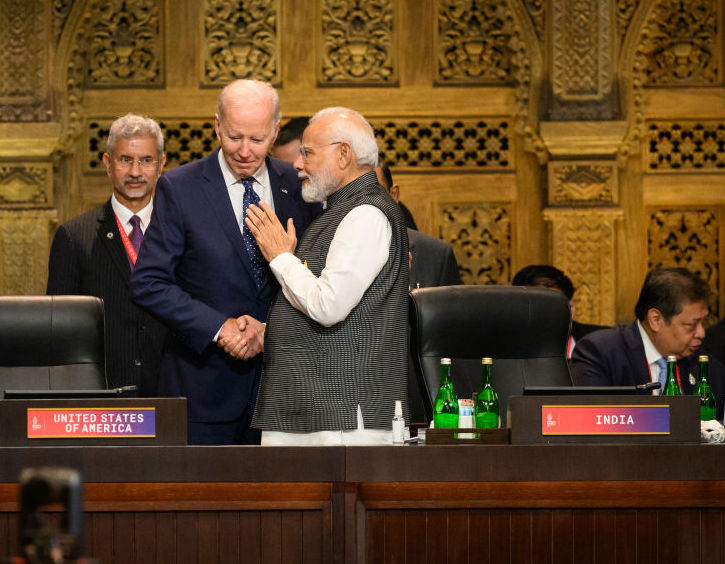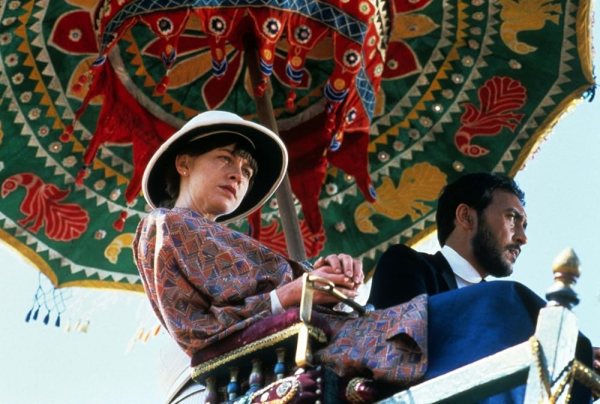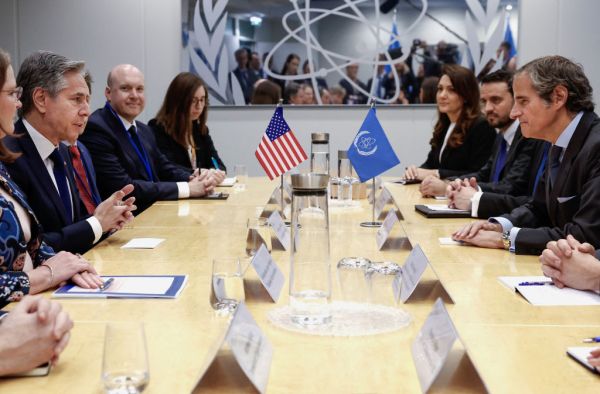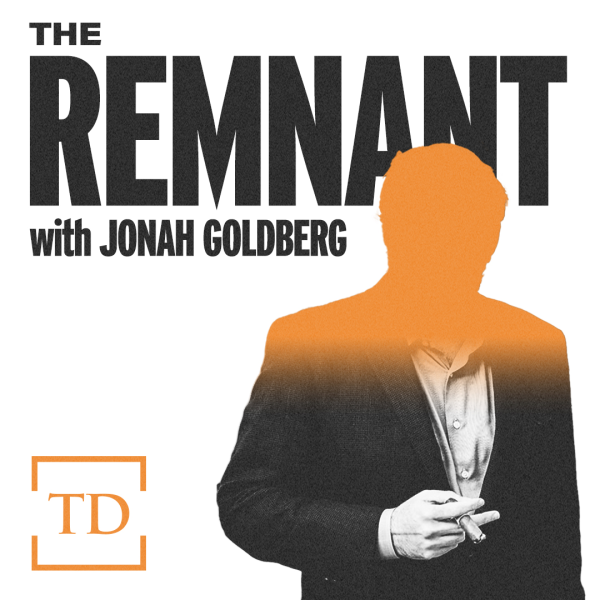Indian Prime Minister Narendra Modi’s visit to the U.S. this week has included meetings with corporate titans, congressional leaders, and top United Nations officials. But it’s Thursday’s summit with President Joe Biden that could do the most to deepen the two countries’ ties as India’s relationship with Russia evolves and as Modi and Biden discuss how best to confront a common rival: China.
The U.S. strategic partnership with India—which recently surpassed China as the world’s largest country and the United Kingdom as the fifth-largest economy—dates back more than two decades and looks to be growing stronger. Trade between the U.S. and India reached a new high in 2022 at more than $190 billion, and American officials recently unveiled plans to collaborate with India on technologies like quantum computing, artificial intelligence, and 5G wireless networks—all fields historically dominated by Beijing. That’s in addition to U.S. hopes for developing a semiconductor “ecosystem” in India by helping it build out its design, manufacturing, and fabrication capabilities of the vital technology.
But addressing threats posed by an ascendant China will also require strengthened defense cooperation with New Delhi, American officials believe.
Modi’s trip lays the groundwork for bringing these plans to fruition. The U.S. and India are expected to announce greater military technology cooperation, including, according to Indian media, a multimillion dollar deal for an Indian state-owned aerospace company to co-produce General Electric jet engines.
The agreement would mark a rare move giving India access to American defense technologies—something that has been complicated in the past by strict U.S. government licensing laws for exports and India’s use of Russian weapons. It would also cement India’s efforts to diversify its weapons acquisitions. Although Russia remains India’s largest arms supplier, its share of India’s overall defense imports fell from 62 percent in 2017 to 45 percent in 2022, according to a report by the Stockholm International Peace Research Institute.
Still, Russia and India retain a close relationship—one that Indian officials have touted as “exceptionally steady” and “time-tested.” That bond, which began with the Soviet Union during the Cold War, has led India to abstain from all U.N. resolutions condemning Russia’s invasion of Ukraine. And India’s imports of Russian oil—discounted amid U.S.-led efforts to cut off Moscow’s markets—have increased by 16 percent since the invasion’s start.
Washington hopes its latest overtures will weaken India’s dependence on Russia, particularly for military technology. “The U.S. is hoping it will become a significant player in India’s defense sector, and it is already emerging as one,” says Harsh V. Pant, vice president for studies and foreign policy at Observer Research Foundation, a New Delhi-based think tank. “But Russia cannot be dislodged in a matter of years. It’ll need a decade’s worth of investments.”
In the meantime, the U.S. will likely continue to overlook India’s tacit support for Russia in the interest of countering China. And as the shared Asian adversary strengthens its bond with Russia, India too will likely look to move away from its historic partner in Moscow.
“I think there is a realization in India today that Russia is becoming, to some extent, a junior partner of China,” Jitendra Nath Misra, a professor of diplomatic practice at O.P. Jindal Global University and a former Indian diplomat, tells The Dispatch. “That is extremely worrisome for India, which wants a multipolar world.”
Relations between China and India cratered in 2020 after clashes along the countries’ Himalayan border left 20 Indian soldiers dead. Tensions continue to simmer over the disputed frontier regions, forcing India to look for new supporters as it seeks to counter Chinese regional influence. The U.S. has been more than willing to oblige, viewing India as a fitting Indo-Pacific partner because of its shared democratic values.
“We continue to move further down the road of strengthening the partnership between our countries,” Secretary of State Antony Blinken said to the U.S.-India Business Council in Washington this month. “Simply put, we see this defining relationship as a unique connection between the world’s oldest and largest democracies, with a special obligation now to demonstrate that our governments can deliver for and empower all of our citizens.”
But will that “unique connection” ever become a treaty alliance? It’s unlikely.
New Delhi has long been reluctant to enter a formal military alliance with any great power, valuing autonomy above all in its geopolitical strategy. The U.S. has floated India’s membership in “NATO Plus”—the 31-member defensive pact, plus Israel, New Zealand, Japan, Australia, and South Korea—but Indian officials aren’t biting. They instead look to the “Quad”—a security partnership between India, the U.S., Japan, and Australia—as a regional counterweight to China. The coalition doesn’t include a mutual defense pact, but does conduct joint military exercises with a focus on enhanced defense cooperation.
Modi’s visit should deepen those growing military ties and send an explicit message to China. “India tomorrow is not going to come out and say, ‘I’m going to become a part of NATO, or I’m going to become a treaty alliance partner of the U.S.’ But the strategic partnership between the two will continue to grow because of the structural changes that we’re witnessing,” Pant says. “The U.S. has recognized that even an independent India that can stand up against China is good for the U.S.”
But there’s one lingering concern on the minds of some policy makers in New Delhi: whether Washington’s attempted “thaw” with Beijing might leave India out in the cold.
Last week, Blinken traveled to China—the first such visit by a U.S. secretary of state in five years—for meetings with Chinese President Xi Jinping and other high-ranking officials. The meeting didn’t appear to achieve much for now, but some Indian officials remain haunted by the specter of a “Group of Two” arrangement in which Beijing and Washington come up with a way to coexist as the world’s predominant world powers. In the worst case scenario, the thinking goes, the two divvy up their respective spheres of influence to keep the peace.
“With revival of exchanges at the top-level, ties between the U.S. and China could be in for a reset,” says Misra. “We don’t know what kind of world it will be; thus, this window of opportunity between India and the United States may not last long.”
But other analysts are heartened by the U.S. and India’s shared values, arguing that recent talks between U.S. and Chinese officials are merely a way to de-escalate tensions amid China’s increasingly aggressive military maneuvers in the region.
“India is the fastest rising democracy in the world, and it can really be a counterweight to China. I think that’s a major factor from the American point of view,” Sreeram Chaulia, dean of the Jindal School of International Affairs, tells The Dispatch. “The expectation in India is that the U.S. will not concede the Indo-Pacific on a platter to China.”








Please note that we at The Dispatch hold ourselves, our work, and our commenters to a higher standard than other places on the internet. We welcome comments that foster genuine debate or discussion—including comments critical of us or our work—but responses that include ad hominem attacks on fellow Dispatch members or are intended to stoke fear and anger may be moderated.